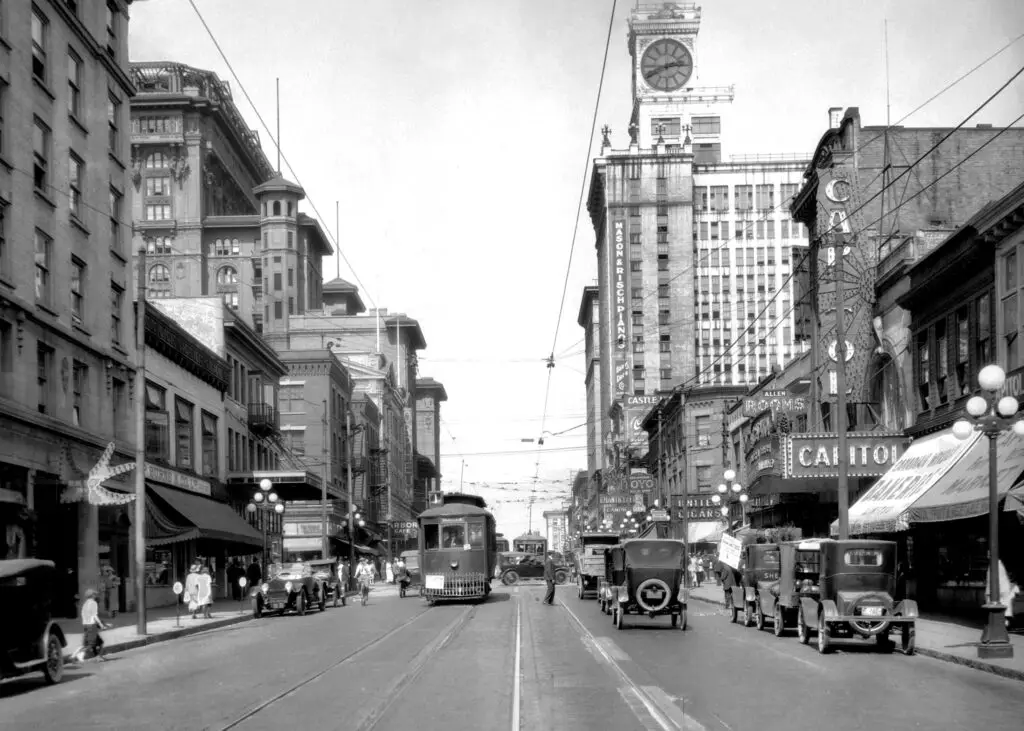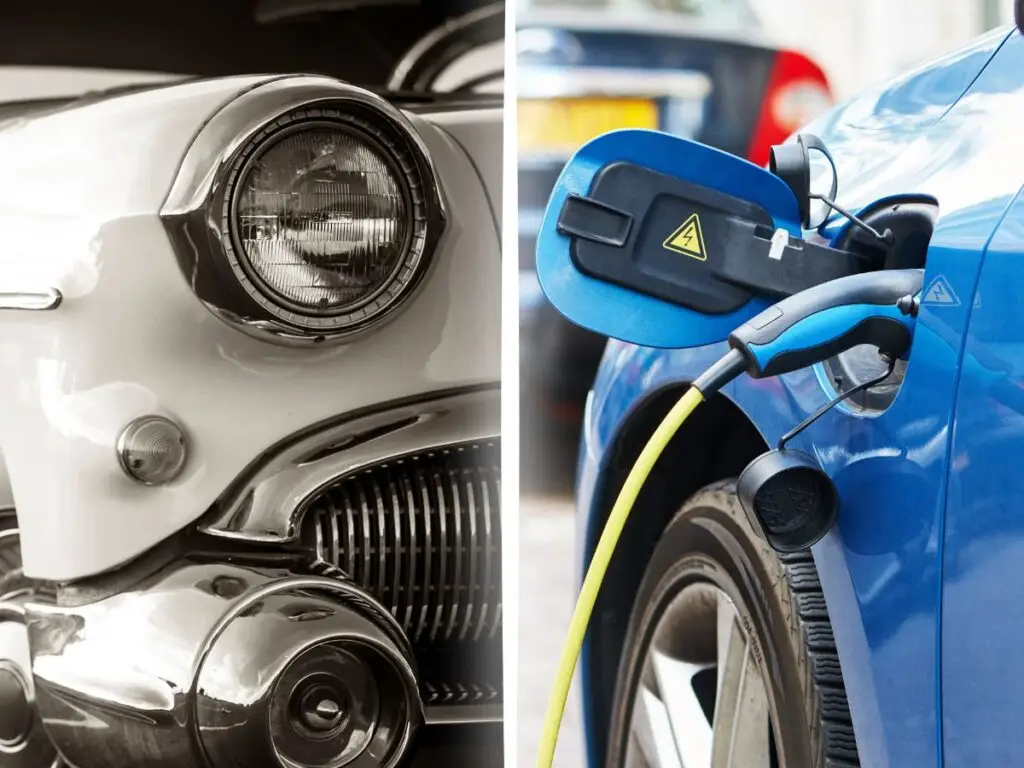How is the transition from driving gas-powered to electric vehicles similar to the transition from the horse and carriage to the automobile in the early 20th century?
By Ken Hendricks
What it must have been like to witness the first automobile driving down Hastings Street in Vancouver, British Columbia! The year 1903 marked the arrival of the very first automobile in the province. Perhaps it would have been like seeing your very first Nissan Leaf in 2010, or Tesla Roadster back in 2008. Cities were a lot different back then. In 1903, people walked to where they needed to go, they rode bikes, took a trolley, or arrived at their destination in a carriage pulled by a horse. Who could have imagined that within a span of 20 years automobiles would fill the city streets, and it seemed like everyone who was anyone owned one. But it wasn’t exactly like that. And for those who think we are not accelerating the transition to electric vehicles fast enough, we can learn something about how things were back then, and apply the knowledge to what we are going through now.
Almost 20 years after its arrival, the automobile began to fill the streets of big cities. But the transition from horse and buggy to the automobile as the primary means of transportation actually spanned several decades and varied widely across regions. The development of the automobile began in the late 19th century, with early pioneers like Karl Benz and Gottlieb Daimler creating the first practical gasoline-powered vehicles. These early automobiles were expensive and unreliable, thus limiting their adoption. During this early period, automobiles were considered a novelty and only the wealthy could afford one. They were often seen as status symbols rather than a practical means of transportation. Horse-drawn carriages remained the dominant means of transportation for most people. But by the early 20th century technology had lead to improvements in reliability, affordability, and mass production. Companies like Ford introduced assembly line production methods, making automobiles more accessible to the general public.
The increasing affordability and availability of automobiles led to the eventual shift away from horse-drawn transportation. Initially, automobiles were primarily used for short trips and leisure activities, being seen as not very practical for long journeys. However, their convenience and efficiency began to make them more popular for daily commuting and longer-distance travel. Finally, by the 1930s, automobiles had become a common sight in cities and towns across B.C., gradually replacing horse-drawn carriages and carts as the primary mode of transportation.

The automobile took over as the primary means of transportation because it was superior to other types of mobility. But widespread adoption was hindered by the lack of a supporting infrastructure. The infrastructure that was in place, designed to support accessible modes of transportation for the time, had to be transformed, and it certainly went through its growing pains. The development of better road infrastructure, such as paved roads and highways, supported the eventual growth of automobile usage. But getting out of the city was still problematic. Not only was there lack of paved roads, but there was a lack of gas stations available for refueling along the way. In today’s lingo, as it applies to electric vehicles, we call this “range or charge anxiety”—back then it may as well have been called “refueling anxiety.” Indeed, even if there were gas stations en route, most were not even open past 5:00pm, thus limiting your commute even further. This was even the case in major cities like Vancouver up until the 1950s. Municipalities eventually had to pass municipal bylaws forcing gas stations to remain open to 11:00pm.
As more and more people switched to driving automobiles, and cities and towns across the country grew, it become apparent that new traffic management systems were required. It wasn’t until the 1920s that three-coloured traffic lights were installed. It was at this time that the colour red become universally accepted to mean “Stop.” It would be another decade yet before automatic traffic signals were installed. And you can imagine all the traffic accidents back then. But where you had your car serviced was not at a local auto repair shop, but at a bicycle repair shop, as that was what was available at the time. By the 1930s, the local service station became the “one-stop” shop for all automotive service needs. And as the market for automobiles grew, and they became more complex, businesses began to specialize into the repair and service infrastructure we have today. The infrastructure that supports the modern transportation system did not evolve overnight, and did not go without its growing pains.
There are many parallels to what we will be experiencing in our shift to driving electric vehicles. Our present day service and repair infrastructure evolved out of the need to better service gas-powered vehicles. Electric (and soon automation) are adding new challenges to this infrastructure and industry needs time to adapt, retool, and retrain.
There are those who are critical of all the government incentives being offered to purchase electric vehicles. They even make the case that if the electric vehicle is superior, why do we need to offer people incentives to buy them? But incentives are nothing new and were used in the past to encourage people to purchase automobiles.
Beginning in the early 1900s, governments began offering tax incentives to encourage people to buy automobiles. Early models were still very expensive and only the wealthy could afford them. If the automobile market was to grow it needed to become more accessible to everyday people. In response, municipalities reduced or eliminated taxes on automobiles, or lowered the registration fees for vehicle owners. These tax breaks aimed to make car ownership more appealing and affordable.
Governments also recognized the potential economic benefits for tourism, travel, and lifestyle. They actively promoted automobile travel as a way to boost local economies by attracting tourists. This promotion included advertising campaigns, the establishment of scenic routes, and the placement of road signs to guide travellers.
While electric vehicles may be viewed as superior technology that offers added benefits for consumers, the primary impetus behind their growth is finding a solution to climate change. But environmental crises are nothing new and have been documented throughout history. In fact, at the turn of the 20th century the problem of horse manure in big cities was a significant environmental issue. The large number of horses in cities led to a staggering amount of manure left on roadways.
The sheer volume of horse manure created a range of problems. Foul odour permeated the air as streets were lined with manure, creating an unpleasant and unsanitary environment. The accumulation of manure also attracted flies and other pests, contributing to the spread of disease and posing a threat to public health.
While the automobile’s primary appeal was not centred on solving the horse manure problem, it was soon recognized that it alleviated many of the problems caused by the extensive use of horses in urban areas. The transition to automobiles offered a cleaner, more efficient transportation alternative with a lower environmental impact, which ultimately helped improve the overall quality of life in big cities.
Once again, technology is solving the problems of the past by putting an end to an inferior technology. But it is not simply a matter of more people buying more cars. If we want to successfully transform our transportation system and build a better tomorrow, it will take investment, support, and time.






